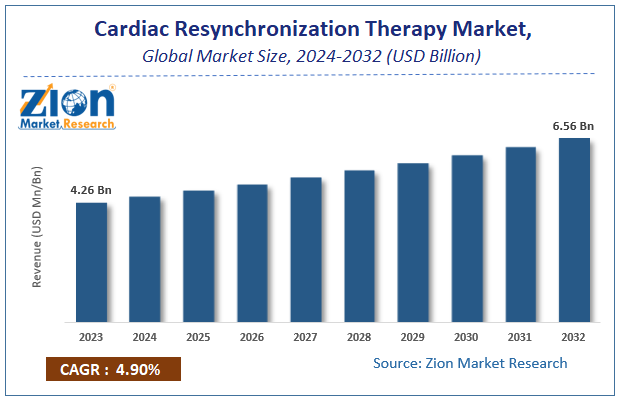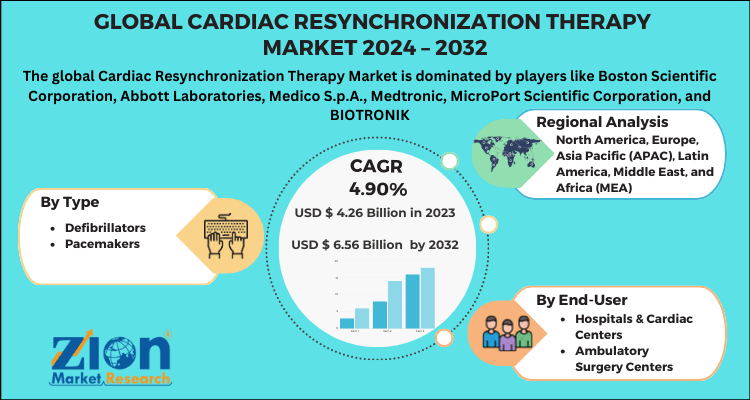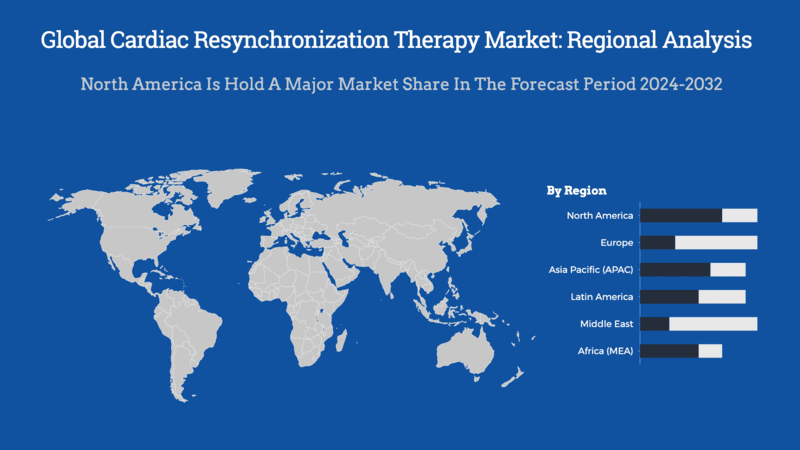Cardiac Resynchronization Therapy Market Trend, Share, Growth, Size Analysis, Forecast 2032

Cardiac Resynchronization Therapy Market Analysis By End User (Ambulatory Surgery Centers and Hospitals & Cardiac Centers), by Product Type (Cardiac Resynchronization Therapy Pacemaker and Cardiac Resynchronization Therapy Defibrillator), and By Region - Global Industry Perspective, Comprehensive Analysis, and Forecast, 2024-2032
| Market Size in 2023 | Market Forecast in 2032 | CAGR (in %) | Base Year |
|---|---|---|---|
| USD 4.26 Billion | USD 6.56 Billion | 4.9% | 2023 |
Cardiac Resynchronization Therapy Market: Industry Prospective
The global Cardiac Resynchronization Therapy market size accrued earnings worth approximately USD 4.26 Billion in 2023 and is predicted to gain revenue of about USD 6.56 Billion by 2032, is set to record a CAGR of nearly 4.9% over the period from 2024 to 2032.
Cardiac Resynchronization Therapy Market: Overview
Cardiac resynchronization treatment was launched at the end of twentieth century. It has brought a paradigm shift in the medical treatment and has proved a boon for patients with systolic heart failure symptoms. The key objective of the cardiac resynchronization therapy is restoring of mechanical synchrony through electric activation of heart in a synchronized way. Clinical trials have demonstrated favorable outcomes when the patients exhibiting the heart failure symptoms are given combined cardiac resynchronization & medical treatment. Moreover, these combined treatments not only diminishes heart failure hospitalizations but also minimizes rate of mortality along with enhancing quality of life of patients. `
Cardiac Resynchronization Therapy Market: Growth Factors
Cardiac resynchronization treatment has brought revolutionary changes in the patient care sector and this will boost the market growth over the upcoming years. With CRT or cardiac resynchronization therapy established as device treatment for heart failure patients, the cardiac resynchronization therapy industry is likely to gain traction over the forthcoming years. Apart from this, current know-how of implantation procedures, breakthroughs in device-based systems, and successful clinical trial outcomes has notably influenced the expansion of the cardiac resynchronization therapy business in recent years.
Furthermore, the therapy has proved to be an effective tool for treating patients with refractory heart failure symptoms, patients with serious left ventricle systolic dysfunctioning, and intraventricular conduction delay. CRT improves exercise tolerance and minimizes LV dilation, thereby proliferating market growth. According to studies conducted by NIH researchers, cardiac resynchronization treatment has resulted in reduction in proinflammatory and neurohormonal biomarkers. It also helps in enhancing heart pump proficiency and restoring ventricular contraction synchrony along with improving heart stole volume as well as LV contraction & ejection fraction. The main aim of the cardiac resynchronization treatment is maintaining interventricular & intraventricular synchrony. Apparently, introduction of novel cardiac resynchronization treatment systems along with growing trend of using wireless cardiac resynchronization therapy systems as well as adaptive optimization of CRT programming & multipoint pacing are predicted to influence the growth of cardiac resynchronization therapy market in the next decade.
Key Insights
- As per the analysis shared by our research analyst, the global Cardiac Resynchronization Therapy Market is estimated to grow annually at a CAGR of around 4.9% over the forecast period (2024-2032).
- In terms of revenue, the global Cardiac Resynchronization Therapy Market size was valued at around USD 4.26 Billion in 2023 and is projected to reach USD 6.56 Billion by 2032.
- Based on the type, the Cardiac Resynchronization Therapy Defibrillators (CRT-D) CRT-Ds combine the functions of a pacemaker and a defibrillator, making them critical for patients with severe heart failure at high risk of sudden cardiac arrest. This segment accounted for more than 74.71% of the CRT market share in 2022.
- Based on the End-User, the Hospitals and Cardiac Centers: These facilities are equipped with advanced technologies and specialized medical staff, making them the primary settings for CRT procedures. In 2022, hospitals held the largest share of about 52.08% of the CRT market.
- Based on the Region, North America this region held more than 49.9% share of the CRT market in 2022, driven by advanced healthcare infrastructure, a high prevalence of heart disease, and significant research and development investments in medical technologies.
Cardiac Resynchronization Therapy Market: Dynamics
Key Growth Drivers
The cardiac resynchronization therapy (CRT) market is primarily driven by the increasing prevalence of heart failure and cardiovascular diseases, particularly among the aging population. The rising awareness about the benefits of CRT devices in improving heart function and quality of life fuels market growth. Technological advancements, including the development of wireless CRT devices and remote monitoring capabilities, enhance patient management and drive adoption. Additionally, favorable reimbursement policies and increased healthcare spending in developed countries support the growth of the CRT market. The growing preference for minimally invasive procedures also contributes to the increasing demand for CRT devices.
Restraints
Despite its benefits, the CRT market faces challenges such as the high cost of CRT devices and implantation procedures, which can limit access in low- and middle-income countries. The complexity of the procedure requires specialized medical professionals, leading to limited availability in regions with inadequate healthcare infrastructure. Furthermore, the risk of complications associated with CRT implantation, including device malfunctions and infections, can deter patients and healthcare providers. Regulatory challenges and stringent approval processes for new CRT devices also pose barriers to market growth.
Opportunities
Emerging markets, particularly in Asia-Pacific and Latin America, offer significant growth opportunities for the CRT market due to the increasing healthcare investments and improving access to advanced cardiac care. Ongoing research and development in the field of cardiac therapies, including innovations in leadless and battery-free CRT devices, provide opportunities for market expansion. Additionally, the integration of artificial intelligence (AI) and machine learning in CRT devices for real-time data analysis and predictive diagnostics enhances treatment outcomes. Expanding telehealth and remote patient monitoring solutions further create new avenues for market growth.
Challenges
One of the major challenges in the CRT market is the limited awareness and underdiagnosis of heart failure in developing regions, leading to lower adoption rates of CRT devices. Patient reluctance to undergo invasive procedures and concerns regarding the long-term safety and efficacy of CRT devices also present challenges. Additionally, the high competition among key market players and the presence of alternative cardiac therapies, such as implantable cardioverter defibrillators (ICDs) and left ventricular assist devices (LVADs), may impact market growth. Addressing the disparities in access to advanced cardiac care remains a crucial challenge for the global CRT market.
Cardiac Resynchronization Therapy Market Report Scope
| Report Attributes | Report Details |
|---|---|
| Report Name | Cardiac Resynchronization Therapy Market |
| Market Size in 2023 | USD 4.26 Billion |
| Market Forecast in 2032 | USD 6.56 Billion |
| Growth Rate | CAGR of 4.9% |
| Number of Pages | 202 |
| Key Companies Covered | Boston Scientific Corporation, Abbott Laboratories, Medico S.p.A., Medtronic, MicroPort Scientific Corporation, and BIOTRONIK |
| Segments Covered | By Type, By End-User, and By Region |
| Regions Covered | North America, Europe, Asia Pacific (APAC), Latin America, Middle East, and Africa (MEA) |
| Base Year | 2023 |
| Historical Year | 2018 to 2022 |
| Forecast Year | 2024 - 2032 |
| Customization Scope | Avail customized purchase options to meet your exact research needs. Request For Customization |
Cardiac Resynchronization Therapy Market: Segmentation Analysis
The study provides a decisive view of the Cardiac Resynchronization Therapy Market by segmenting the market based on by product type, by end-user, and by region. All the segments have been analyzed based on present and future trends and the market is estimated from 2024 to 2032.
Based on the product type, the main divisions in the CRT market include Cardiac Resynchronization Therapy – Defibrillators (CRT-D), Wireless – Cardiac Resynchronization Therapy (Wireless-CRT), and Cardiac Resynchronization Therapy – Pacemakers (CRT-P). The selection of CRT implant is contingent upon several parameters like as age, gender, and others. The CRT-D segment held the largest market share in 2023.
Cardiac resynchronization treatment – defibrillator (CRT-D) employs an implantable cardioverter defibrillator (ICD) to enhance the synchronization of the heart's rhythm. This device employs three leads, with one connected to the right atrium and one connected to each of the ventricles.
Based on the end-user Segment includes Hospitals & Cardiac Centers and Ambulatory Surgery Centers.
The regional segment includes the current and forecast demand for North America, Europe, Asia Pacific, Latin America, and the Middle East and Africa.
Global Cardiac Resynchronization Therapy Market: Regional Analysis
The Cardiac Resynchronization Therapy (CRT) market demonstrates varied growth patterns across different regions, influenced by factors such as healthcare infrastructure, prevalence of cardiovascular diseases, and technological advancements.
North America
North America holds a dominant position in the CRT market, driven by advanced healthcare infrastructure, extensive research and development activities, and a high prevalence of cardiovascular diseases necessitating advanced treatments like CRT. The presence of major market players and favorable reimbursement policies further bolster the market in this region. The United States, in particular, continues to lead, supported by a large patient base and ongoing technological innovations.
Europe
Europe represents a significant segment of the CRT market, with countries like Germany, France, the United Kingdom, Spain, and Italy contributing substantially. The region benefits from a strong emphasis on healthcare quality and accessibility, along with proactive strategies by leading companies focusing on consumer assessment and competitive capabilities. These factors position the European CRT market on an upward trajectory, fostering both domestic and international interest.
Asia-Pacific
The Asia-Pacific region is emerging as the fastest-growing market for CRT, attributed to rapid urbanization, increasing healthcare infrastructure investments, and a rising prevalence of cardiovascular diseases. Countries such as China, India, and Japan are at the forefront, with factors like a growing middle-class population, improving healthcare facilities, and favorable reimbursement scenarios driving demand. Both multinational and local companies are investing in this region to meet the expanding healthcare needs.
Latin America
Latin America is experiencing steady growth in the CRT market, fueled by rising income levels and continued urbanization. These socioeconomic factors enhance purchasing power and healthcare access, contributing to increased adoption of CRT devices. Countries like Brazil and Argentina are notable contributors, with expanding healthcare infrastructure supporting market development.
Middle East and Africa
The Middle East and Africa region is witnessing an upward trend in the CRT market, supported by robust demand from countries such as Saudi Arabia, the UAE, and South Africa. Factors driving this growth include increasing healthcare expenditure, a growing population, and a high prevalence of cardiovascular conditions. Investments in healthcare infrastructure and services are further propelling market expansion in this region.
Cardiac Resynchronization Therapy Market: Competitive Players
Key players profiled in the report include:
- Boston Scientific Corporation
- Abbott Laboratories
- Medico S.p.A.
- Medtronic
- MicroPort Scientific Corporation
- and BIOTRONIK
The global cardiac resynchronization therapy market is segmented as follows:
By Product Type
- Cardiac Resynchronization Therapy Defibrillators
- Cardiac Resynchronization Therapy Pacemakers
By End User
- Hospitals & Cardiac Centers
- Ambulatory Surgery Centers
By Region
- North America
- The U.S.
- Canada
- Europe
- France
- The UK
- Spain
- Germany
- Italy
- Rest of Europe
- Asia Pacific
- China
- Japan
- India
- South Korea
- Southeast Asia
- Rest of Asia Pacific
- Latin America
- Brazil
- Mexico
- Rest of Latin America
- Middle East & Africa
- GCC
- South Africa
- Rest of Middle East & Africa
Table Of Content
Methodology
FrequentlyAsked Questions
With CRT or cardiac resynchronization therapy established as device treatment for heart failure patients, the cardiac resynchronization therapy industry is likely to gain traction over the forthcoming years.
The CAGR of the industry is expected to be nearly 4.8% during the forecast timeline.
Asia Pacific will contribute remarkably towards the global market share over the estimated timeline.
The key market players include Abbott, Medtronic, MicroPort Scientific Corporation, Boston Scientific Corporation, Medico S.p.A., and BIOTRONIK.
Choose License Type
List of Contents
Industry ProspectiveCardiac Resynchronization TherapyOverviewCardiac Resynchronization TherapyGrowth FactorsKey InsightsDynamicsCardiac Resynchronization TherapyMarket Report ScopeCardiac Resynchronization TherapySegmentation AnalysisRegional AnalysisCompetitive PlayersThe global cardiac resynchronization therapy market is segmented as follows:RelatedNews
HappyClients
Zion Market Research
Tel: +1 (302) 444-0166
USA/Canada Toll Free No.+1 (855) 465-4651
3rd Floor,
Mrunal Paradise, Opp Maharaja Hotel,
Pimple Gurav, Pune 411061,
Maharashtra, India
Phone No +91 7768 006 007, +91 7768 006 008
US OFFICE NO +1 (302) 444-0166
US/CAN TOLL FREE +1 (855) 465-4651
Email: sales@zionmarketresearch.com
We have secured system to process your transaction.
Our support available to help you 24 hours a day, five days a week.
Monday - Friday: 9AM - 6PM
Saturday - Sunday: Closed








